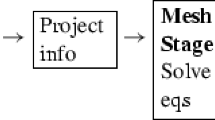Abstract
The paper aims to introduce new fluid–structure interaction (FSI) tests to compare experimental results with numerical ones. The examples have been chosen for a particular case for which experimental results are not much reported. This is the case of FSI including free surface flows. The possibilities of the Particle Finite Element Method (PFEM) [1] for the simulation of free surface flows is also tested. The simulations are run using the same scale as the experiment in order to minimize errors due to scale effects. Different scenarios are simulated by changing the boundary conditions for reproducing flows with the desired characteristics. Details of the input data for all the examples studied are given. The aim is to identifying benchmark problems for FSI including free surface flows for future comparisons between different numerical approaches.
Similar content being viewed by others
References
Idelsohn SR, Oñate E, Del Pin F and Calvo N (2006). Fluid–structure interaction using the particle finite element method. Comput Method Appl Mech Eng 195: 2100–2123
Tezduyar TE (2001). Finite element methods for flow problems with moving boundaries and interfaces. Arch Comput Methods Eng 8: 83–130
Akin JE, Tezduyar TE and Ungor M (2007). Computation of flow problems with the mixed Interface-Tracking/Interface-Capturing Technique (MITICT). Comput Fluids 36: 2–11
Cruchaga MA, Celentano DJ and Tezduyar TE (2007). A numerical model based on the mixed Interface-Tracking/Interface-Capturing Technique (MITICT) for flows with fluid–solid and fluid–fluid interfaces. Int J Numer Methods Fluids 54: 1021–1030
Idelsohn SR, Oñate E and Del Pin F (2004). The particle finite element method: a powerful tool to solve incompressible flows with free-surfaces and breaking waves. Int J Numer Methods Eng 61: 964–984
Larese A, Rossi R, Oñate E, Idelsohn SR (2007) Validation of the particle finite element method (PFEM) for simulation of the free surface flows. Accepted in Int J Comput Method
Osher S and Fedkiw RP (2001). Level set methods: an overview and some recent reults. J Comput Phys 169: 463–502
Osher S and Fedkiw RP (2006). Level set methods an dynamic implicit surfaces. Springer, Berlin
Tezduyar T, Aliabadi S and Behr M (1998). Enhanced-Discretization Interface-Capturing Technique (EDICT) for computation of unsteady flows with interfaces. Comput Methods Appl Mech Eng 155: 235–248
Cruchaga MA, Celentano DJ and Tezduyar TE (2005). Moving-interface computations with the Edge-Tracked Interface Locator Technique (ETILT). Int J Numer Methods Fluids 47: 451–469
Roubtsova V and Kahawita R (2006). The SPH technique applied to free-surface flows. Comput Fluids 35: 1359–1371
Bonet J, Kulasagaram S, Rodriguez-Paz MX and Profit M (2004). Variational formulation for the smooth particle hydrodynamics (SPH) simulation of fluid and solid problems. Comput Methods Appl Mech Eng 193: 1245–1256
Oñate E, Idelsohn SR, Del Pin F and Aubry R (2004). The particle finite element method. An overview. Int J Comput Method 2: 267–307
Idelsohn SR, Oñate E, Calvo N and Del Pin F (2003). The meshless finite element method. Int J Numer Methods Eng 58(6): 893–912
Idelsohn SR, Calvo N and Oñate E (2003). Polyhedrization of an arbitrary 3D point set. Comput Methods Appl Mech Eng 192: 2649–2667
Donea J and Huerta A (2003). Finite elements methods for flow problems. Wiley, New York
Zienkiewicz OC, Taylor R.L and Nitharasu P (2005). The finite element method. Fluid dynamics, vol. III. Elsevier, Amsterdam
Oñate E (2000). A stabilized finite element method for incompressible viscous flows using a finite increment calculus formulation. Comput Methods Appl Mech Eng 182: 355–370
Oñate E and Idelsohn SR (1998). A mesh free finite point method for advective diffusive transport and fluid flow problem. Comput Mech 21: 283–292
Edelsbruner H and Mucke EP (1994). Three dimensional alpha shape. ACM Trans Graph 13: 43–72
Souto-Iglesias A, Delorme L, Pérez-Rojas L and Abril-Pérez S (2006). Liquid moment amplitude assessment in sloshing type problems with smooth particle hydrodynamics. Ocean Eng 33: 1462–1484
Author information
Authors and Affiliations
Corresponding author
Rights and permissions
About this article
Cite this article
Idelsohn, S.R., Marti, J., Souto-Iglesias, A. et al. Interaction between an elastic structure and free-surface flows: experimental versus numerical comparisons using the PFEM. Comput Mech 43, 125–132 (2008). https://doi.org/10.1007/s00466-008-0245-7
Received:
Accepted:
Published:
Issue Date:
DOI: https://doi.org/10.1007/s00466-008-0245-7




